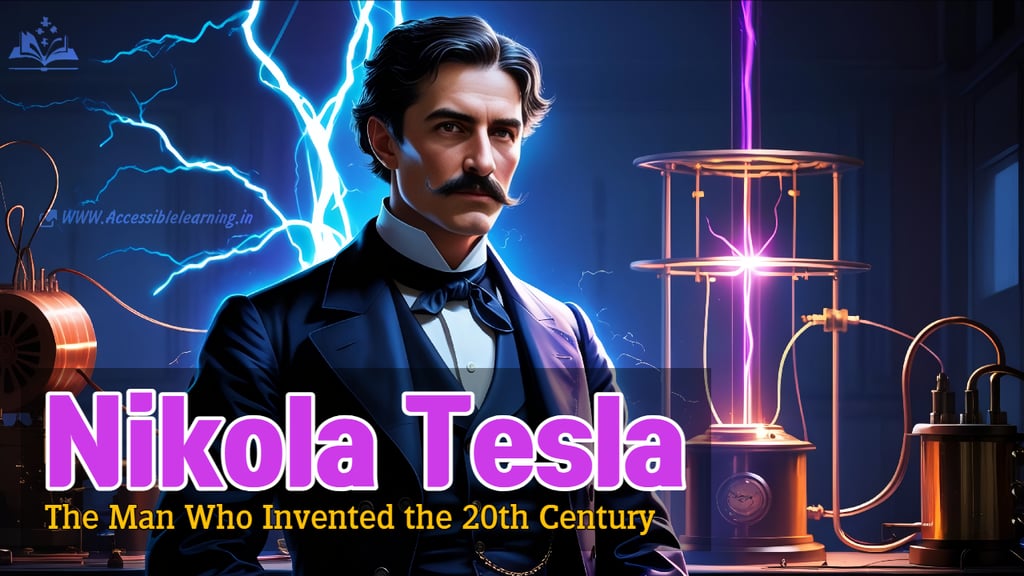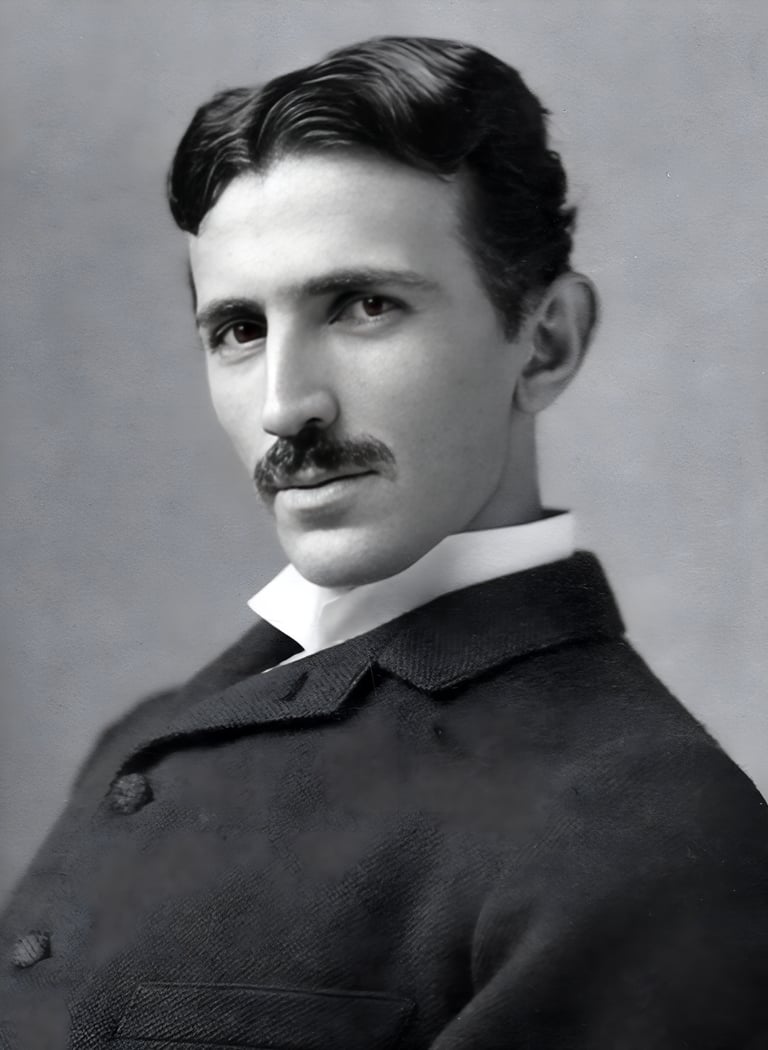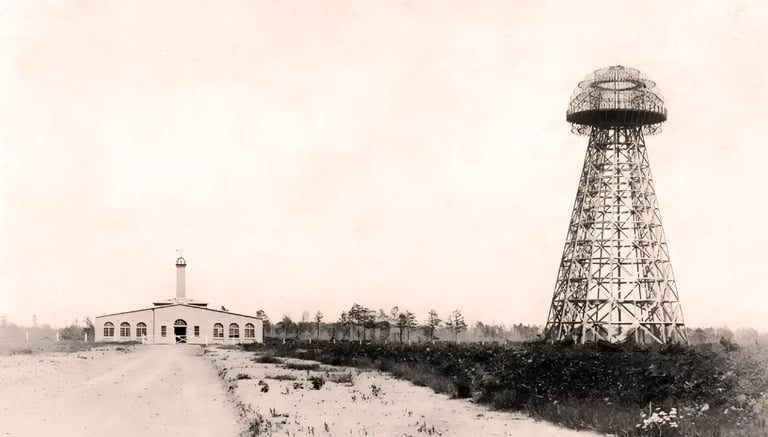
Nikola Tesla: The Man Who Invented the 20th Century
Explore the extraordinary life of Nikola Tesla, the electrical engineering genius whose revolutionary innovations power our modern world. From alternating current to wireless technology, discover how this visionary inventor created the foundation for technology we use today while battling corporate interests and personal challenges.
BIOGRAPHY/HISTORYSCIENCE/PHILOSOPHYTHE GREAT LEADEREDUCATION/KNOWLEDGEHISTORY
Kim Shin
4/3/202511 min read


In the pantheon of history's greatest minds, few figures stand as enigmatically brilliant as Nikola Tesla. Born in a small Croatian village in 1856, Tesla would go on to revolutionize our understanding of electricity and magnetism, laying the groundwork for modern electrical systems that power our world today. Despite his profound contributions, Tesla's story remains partially obscured by time and overshadowed by contemporaries who were often more adept at claiming credit and commercial success. This article explores the remarkable life, groundbreaking innovations, and enduring legacy of one of history's most fascinating inventors.
Early Life and Education
Nikola Tesla was born on July 10, 1856, in the village of Smiljan, part of the Austrian Empire (now Croatia). The son of a Serbian Orthodox priest, Milutin Tesla, and his mother, Đuka Mandić, Tesla was raised in a family that valued intellectual pursuits. Đuka, despite her lack of formal education, was known for her remarkable memory and mechanical ingenuity—traits her son would inherit in abundance.
As a child, Tesla survived a bout with cholera that nearly killed him. During his prolonged recovery, he discovered a passionate interest in reading and developed his extraordinary capacity for visualization. He could memorize entire books and solve complex mathematical problems mentally—abilities that would later serve him well in his engineering career.
After completing his early education at the Higher Real Gymnasium in Karlovac, Tesla enrolled at the Austrian Polytechnic in Graz in 1875. Though an exceptional student initially, he became obsessed with proving that alternating current was viable despite his professors' insistence that it was impossible. This fixation led to declining grades and eventually, his departure without a degree. He later studied philosophy at the University of Prague but again left without completing formal credentials.
The Journey to America and Partnership with Edison
Before coming to America, Tesla worked for the Continental Edison Company in Paris, where he gained practical experience with electrical systems. His improvements to Edison's dynamos caught the attention of company managers, leading to his recommendation to Thomas Edison himself.
In 1884, Tesla arrived in New York with little more than a letter of recommendation from Charles Batchelor to Thomas Edison that famously stated, "I know two great men; one is you, and the other is this young man." Initially hired by Edison, Tesla quickly demonstrated his engineering prowess by solving some of the company's most difficult problems.
Edison allegedly promised Tesla $50,000 (equivalent to over $1 million today) if he could improve Edison's DC generators. When Tesla succeeded, Edison dismissed the payment as a joke, reportedly telling Tesla, "You don't understand our American humor." Tesla immediately resigned, spending the next year digging ditches for $2 a day to survive—a dramatic illustration of the economic vulnerability that would plague him throughout his life despite his intellectual brilliance.
The War of Currents
The philosophical differences between Tesla and Edison extended beyond personal friction to their fundamental vision for electrical power distribution. Edison's direct current (DC) system was limited by its inability to transmit electricity over long distances without significant loss of power. Tesla's alternating current (AC) system, by contrast, could efficiently transmit electricity across vast distances when stepped up to high voltages using transformers.
Edison, having invested heavily in DC infrastructure and patents, launched an aggressive campaign to discredit AC power, including public demonstrations where animals were electrocuted using alternating current. Most notoriously, Edison encouraged the use of AC for the first electric chair execution to associate Tesla's system with death in the public imagination.
The tide turned decisively in favor of AC when industrialist George Westinghouse purchased Tesla's patents for $60,000, plus royalties. Together, they secured the contract to illuminate the 1893 World's Columbian Exposition in Chicago—creating a breathtaking "White City" powered entirely by alternating current. Shortly thereafter, they won the contract to develop hydroelectric power at Niagara Falls, building the world's first major AC power plant.


Groundbreaking Innovations in Detail
Polyphase System and Induction Motor
Tesla's AC polyphase system, patented in 1888, wasn't merely an improvement on existing technology—it was a revolutionary approach to power generation and transmission. The system featured multiple circuits with alternating currents that were out of phase with each other, creating a rotating magnetic field.
This innovation led directly to Tesla's development of the AC induction motor, which has been called one of the ten greatest discoveries of all time. Unlike previous electric motors, Tesla's required no commutator or brushes, eliminating the sparking, maintenance problems, and fire hazards that plagued DC motors. The simplicity and reliability of this design made it the workhorse of industrial applications for over a century, and variations of Tesla's original design still power everything from household appliances to industrial machinery today.
Tesla Coil and High-Frequency Research
The Tesla coil, invented in 1891, transformed relatively low-voltage, high-current electricity into extremely high-voltage, low-current electricity at high frequencies. This invention was revolutionary not just for its spectacular visual effects but for demonstrating principles fundamental to radio transmission.
Through his experiments with Tesla coils, he discovered that high-frequency currents traveled preferentially over the surface of conductors rather than through them—a phenomenon now known as the "skin effect." He also observed that these currents could wirelessly light vacuum tubes several feet away from the coil, demonstrating wireless energy transmission decades before it would become scientifically accepted.
His Colorado Springs laboratory, established in 1899, housed a magnifying transmitter that produced artificial lightning bolts up to 135 feet long—still among the largest ever created by humans. During these experiments, Tesla claimed to have detected signals from extraterrestrial sources, though this remains unverified. More concretely, he discovered terrestrial stationary waves, proving that the Earth could be used as a conductor and was potentially viable for wireless power transmission.
Wireless Technology Beyond Radio
While Tesla is increasingly recognized for his priority in radio development, his wireless vision extended far beyond simple communication. As early as 1891, Tesla described and demonstrated wireless power transmission principles. In an 1898 patent, he detailed a radio-controlled boat that incorporated logical AND gates—a fundamental component of modern computing systems.
His Wardenclyffe Tower project on Long Island was intended to be the first broadcast system for both information and power. The massive facility, designed by renowned architect Stanford White, featured a 187-foot tower topped with a 68-foot copper dome. Underground, an elaborate tunnel system extended 120 feet into the ground. Tesla intended this structure to demonstrate transatlantic wireless communication and power transmission simultaneously.
When investor J.P. Morgan learned that Tesla intended to provide free wireless electricity to the world, he withdrew funding, famously asking, "If anyone can draw on the power, where do we put the meter?" The project's failure devastated Tesla financially and psychologically.
Tesla's Scientific Methodology and Work Habits
Tesla's approach to invention differed markedly from that of most of his contemporaries. While Thomas Edison was famous for systematic trial-and-error experimentation, Tesla worked primarily through visualization, often developing complete inventions in his mind before building physical prototypes.
He claimed to be able to run mental simulations of his devices, allowing him to identify design flaws without physical construction. Modern neuroscientists suggest Tesla may have had an extraordinary form of synesthesia, which allowed him to experience his thoughts as vivid, multi-sensory simulations.
Tesla was known for his rigorous work schedule, often working from 10:30 AM until 5:00 AM the following day. He reportedly slept only two hours per night, though he occasionally compensated with brief naps. Despite his limited sleep, he claimed his mind remained fresh through a practice of "relaxing his brain" through visualization exercises.
His meticulous nature extended to personal habits as well. He required 18 napkins at every meal, cleaned his dining plates with additional napkins before eating, and calculated the cubic volume of food portions. Modern analysis suggests Tesla likely suffered from obsessive-compulsive disorder, though these same tendencies contributed to his precision as an inventor.


Lesser-Known Contributions and Predictions
Lighting Technology
Before his AC motor patents, Tesla developed arc lighting systems and pioneered improvements in incandescent lighting. His work with phosphorescent lighting presaged the development of fluorescent lights by decades. In fact, at the 1893 Chicago World's Fair, Tesla demonstrated wireless fluorescent lights before fluorescent lighting was commercially established.
X-Ray Research
Shortly after Wilhelm Röntgen announced the discovery of X-rays in 1895, Tesla began his own investigations using his high-frequency, high-voltage equipment. He produced some of the earliest X-ray images in America and was the first to warn about the potential hazards of this radiation—observations that would not be taken seriously for decades.
Radar Concepts
Tesla described principles of radar in 1917, proposing that radio waves could be used to detect moving objects such as ships. He suggested that by sending radio waves and analyzing their reflection, one could determine the position and speed of distant objects—a concept that wouldn't be fully developed until World War II.
Computing Machines
In 1898, Tesla demonstrated a radio-controlled boat at Madison Square Garden, which he called "telautomaton." This device incorporated logical switching circuits that Tesla understood would have broader applications. He predicted machines that would have "their own intelligence" and envisioned a future with intelligent machines responding to human language and performing complex tasks—essentially describing concepts that would later become robotics and artificial intelligence.
Vertical Take-Off Aircraft
Tesla designed a vertical take-off and landing (VTOL) aircraft concept in the 1920s, which he called the "flivver." The design featured ducted fans for vertical lift—a concept that predated functional helicopters and is now employed in modern VTOL aircraft designs.
Personal Eccentricities and Later Years
As Tesla aged, his eccentricities became more pronounced. He harbored an intense fear of germs, washing his hands compulsively and requiring hotel staff to bring him 18 fresh towels each day. He had an aversion to pearls, which prevented him from speaking to women wearing them, and was particularly sensitive to sounds, claiming he could hear a fly landing several rooms away.
Tesla never married, believing that chastity helped preserve his creative energy. He did, however, form close friendships with several notable individuals, including author Mark Twain, who frequently visited Tesla's laboratory to witness his experiments.
In his later years, Tesla developed an unusual attachment to pigeons, particularly a white female bird with gray tips on its wings. He claimed, "I loved that pigeon as a man loves a woman, and she loved me." When the bird died, Tesla said that something went out of his life, and he knew his life's work was finished.
Despite having earned millions from his patents, Tesla spent lavishly on his experiments and lived his final years in relative poverty. The Westinghouse Corporation, facing financial difficulties in the 1890s, had convinced Tesla to release them from the royalty agreement for his AC patents—a decision that cost him billions in potential earnings. However, the company did provide Tesla with a modest pension in his later years.


Death and Posthumous Recognition
On January 7, 1943, Tesla died alone in room 3327 of the New Yorker Hotel. He was 86 years old. The coroner determined the cause of death to be coronary thrombosis. Within hours of his death, the FBI ordered the Office of Alien Property to seize all of Tesla's belongings, despite the fact that he had become an American citizen in 1891. This action sparked decades of conspiracy theories regarding the potential military applications of his research.
Tesla's nephew, Sava Kosanović, fought a legal battle to have Tesla's possessions released and eventually transported them to Belgrade, Serbia, where they now reside in the Nikola Tesla Museum. The museum contains more than 160,000 original documents, over 1,700 photographs, and approximately 1,000 plans and drawings.
Recognition of Tesla's contributions has grown significantly since his death:
In 1960, the scientific community acknowledged his fundamental contributions by naming the SI unit of magnetic flux density the "tesla" (symbol: T).
In 1975, the Institute of Electrical and Electronics Engineers (IEEE) created the Nikola Tesla Award for outstanding contributions to the generation or utilization of electrical power.
In 1983, the United States Postal Service issued a commemorative stamp honoring Tesla as part of its Great Americans series.
In 2003, a group of engineers and entrepreneurs founded Tesla Motors (now Tesla, Inc.), naming their revolutionary electric car company after the pioneer of electrical engineering.
In recent years, UNESCO has recognized Tesla's archives as part of the Memory of the World Programme, acknowledging their historical significance.
Tesla's Relevance in the Modern World
Many of Tesla's seemingly fantastical predictions and concepts have become reality in the decades following his death:
Renewable Energy Systems
Tesla advocated the development of renewable energy sources, particularly solar power, stating in 1915, "The day science begins to study non-physical phenomena, it will make more progress in one decade than in all the previous centuries of its existence." Today, as the world transitions toward sustainable energy systems, Tesla's vision seems increasingly prophetic.
Wireless Technology Ecosystem
Tesla's dream of a wirelessly connected world has been realized far beyond what even he might have imagined. From smartphones and Wi-Fi to Bluetooth devices and wireless charging, modern society depends on principles Tesla pioneered. The proliferation of wireless charging technologies, in particular, represents a small-scale realization of his wireless power transmission concept.
Autonomous Systems
Tesla predicted self-driving vehicles and autonomous systems decades before the necessary computing technology existed. In a 1926 interview, he described "self-propelled automata" that would be "capable of behaving as if possessed of intelligence." Today's autonomous vehicles, drones, and robotics systems embody aspects of this vision.
Global Information Network
Perhaps most presciently, Tesla envisioned something remarkably similar to the internet. In a 1926 interview with Collier's magazine, he described a "world wireless system" that would allow for instant communication of news, music, and even pictures between any points on Earth. He predicted that future devices would be "simple and convenient to carry about as today's portable radio," essentially describing modern smartphones almost a century before their creation.


Controversies and Misconceptions
Tesla's legacy has been subject to both neglect and exaggeration. Some enthusiasts attribute nearly all modern technology to Tesla's genius, while skeptics dismiss his more theoretical concepts as the ramblings of an increasingly unstable mind. The truth lies somewhere between these extremes.
Several persistent myths about Tesla bear addressing:
Though often credited with "inventing" alternating current, Tesla did not discover AC (which had been known since Faraday's time). His genius was in developing a complete, practical system for its generation, transmission, and utilization.
Despite claims that Tesla's work was "suppressed" by corporate interests, most of his patents and publications were freely available. His obscurity in the decades following his death had more to do with his personal eccentricities and the highly theoretical nature of his later work.
While Tesla did indeed demonstrate principles of wireless power transmission, his claims about the efficiency and range of such systems likely exceeded what was physically possible with his equipment.
Philosophical Outlook and Enduring Wisdom
Beyond specific technologies, Tesla's philosophical approach to science and invention offers enduring lessons. He was a true interdisciplinary thinker, combining insights from electrical engineering, mechanical engineering, physics, and even aspects of what would now be called environmental science.
Tesla understood the interconnectedness of natural phenomena and sought unified explanations for disparate observations. His holistic approach anticipated aspects of systems thinking that would not become mainstream in scientific discourse until decades after his death.
He was also remarkably prescient about humanity's relationship with technology and energy use. In 1934, he stated, "The scientific man does not aim at an immediate result. He does not expect that his advanced ideas will be readily taken up... His work is like that of the planter—for the future. His duty is to lay the foundation for those who are to come and point the way."
Nikola Tesla represents the quintessential visionary—a mind so forward-thinking that many of his ideas seemed impossible to his contemporaries. His life story reminds us of the power of perseverance, the importance of imagination, and sometimes, the cruel irony that true innovators may not live to see their grandest visions realized.
As we face unprecedented global challenges requiring innovative energy solutions and technological approaches, Tesla's legacy becomes increasingly relevant. His vision of clean, abundant energy, wireless connectivity, and intelligent machines no longer seems like science fiction but rather a roadmap for technological development.
In an age where innovation is often measured in quarterly profits and practical applications, Tesla's pure dedication to discovery for humanity's benefit stands as a powerful counterexample. He once remarked, "I do not think there is any thrill that can go through the human heart like that felt by the inventor as he sees some creation of the brain unfolding to success."
As we enjoy the benefits of the electrical world Tesla helped create, we might reflect on his own words: "The present is theirs; the future, for which I really worked, is mine." Indeed, with each passing decade, as technology catches up to his imagination, Tesla's future becomes increasingly our present. Perhaps the greatest honor we can pay to his legacy is to approach our own technological challenges with the same blend of scientific rigor, boundless creativity, and humanitarian concern that characterized his remarkable life's work.
Subscribe To Our Newsletter
All © Copyright reserved by Accessible-Learning Hub
| Terms & Conditions
Knowledge is power. Learn with Us. 📚


